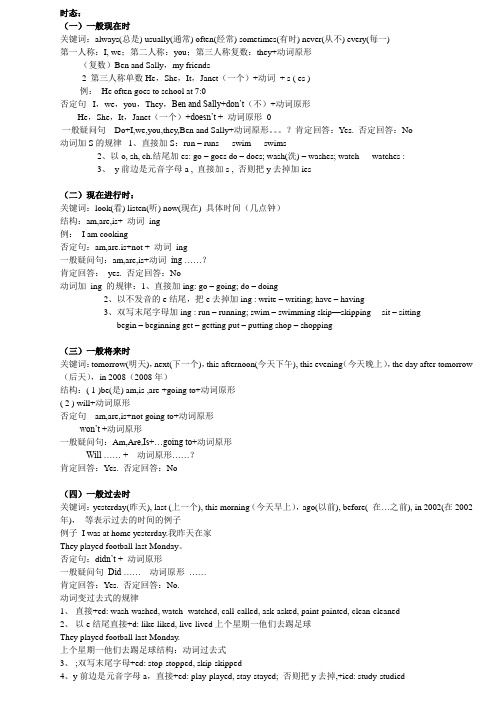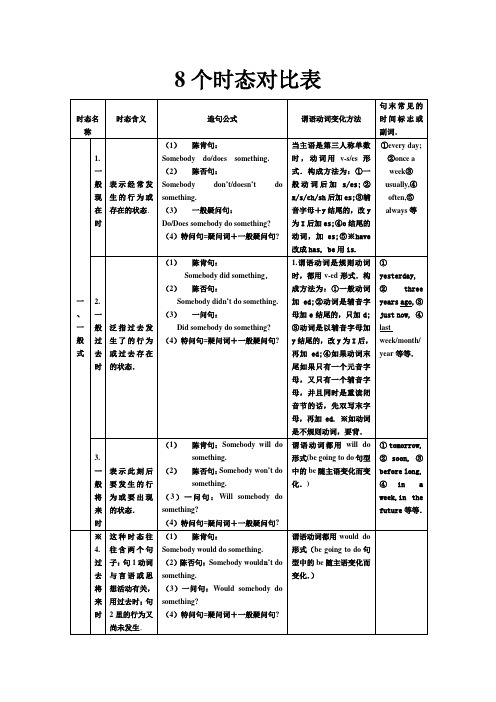几个时态的对比
- 格式:doc
- 大小:85.00 KB
- 文档页数:8

时态:(一)一般现在时关键词:always(总是) usually(通常) often(经常) sometimes(有时) never(从不) every(每一)第一人称:I, we;第二人称:you;第三人称复数:they+动词原形(复数)Ben and Sally,my friends2 第三人称单数He,She,It,Janet(一个)+动词+ s ( es )例:He often goes to school at 7:0否定句I,we,you,They,Ben and Sally+don’t(不)+动词原形He,She,It,Janet(一个)+doesn’t + 动词原形0一般疑问句Do+I,we,you,they,Ben and Sally+动词原形。
?肯定回答:Yes. 否定回答:No动词加S的规律1、直接加S:run – runs swim --- swims2、以o, sh, ch.结尾加es: go – goes do – does; wash(洗) – washes; watch --- watches :3、y前边是元音字母a , 直接加s , 否则把y去掉加ies(二)现在进行时:关键词:look(看) listen(听) now(现在) 具体时间(几点钟)结构:am,are,is+ 动词ing例:I am cooking否定句:am,are.is+not + 动词ing一般疑问句:am,are,is+动词ing ……?肯定回答:yes. 否定回答:No动词加ing 的规律:1、直接加ing: go – going; do – doing2、以不发音的e结尾,把e去掉加ing : write – writing; have – having3、双写末尾字母加ing : run – running; swim – swimming skip—skipping sit – sittingbegin – beginning get – getting put – putting shop – shopping(三)一般将来时关键词:tomorrow(明天),next(下一个),this afternoon(今天下午), this evening(今天晚上),the day after tomorrow (后天),in 2008(2008年)结构:( 1 )be(是) am,is ,are +going to+动词原形( 2 ) will+动词原形否定句am,are,is+not going to+动词原形won’t +动词原形一般疑问句:Am,Ar e,Is+…going to+动词原形Will …… +动词原形……?肯定回答:Yes. 否定回答:No(四)一般过去时关键词:yesterday(昨天), last (上一个), this morning(今天早上),ago(以前), before( 在…之前), in 2002(在2002年),等表示过去的时间的例子例子I was at home yesterday.我昨天在家They played football last Monday。



四大时态总结--------一般现在时、一般将来时、一般过去时、现在进行时一、一般现在时一般现在时表示经常性或习惯性的动作,常与表示频度的时间状语连用,如often, usually, always, sometimes, never, seldom, every week/day/year/month..., once a week, on Sundays等。
动词用第三人称单数的动词变化规则:(只有在第三人称(he, she, it, 一个人名)为主语的肯定句中,动词才用三单式)(1)一般情况下,直接加s runs gets likes(2)结尾是s, x, sh, ch, o,前为辅音字母,结尾加es watches, goes, washes, crosses, mixes, does(3)动词末尾y,前为辅音,将y改为i加es study→studies fly→flies但在y前如果为元音则直接加s buys says plays(4)不规则变形 have—has二、现在进行时现在进行时表示此时此刻或现阶段正在进行的动作。
常与now, at this time, these days, Listen! Look!动词加ing规则(1)直接在动词后加ing. going, starting, working.(2)去掉词尾不发音的e,再加ing. leave--leaving, make---making.注意:如果单词结尾的e发音,则不能去掉,也直接加ing. see –seeing agree - agreeing .(3) 对于动词只有一个元音,而其后跟了一个辅音字母时,双写末尾辅音字母再加ing.sitting, beginning run –running stop –stopping cut –cutting control –controlling(4)以ie结尾,把ie变y再加ing。

一般现在时、现在进行时、一般将来时、一般过去时四大时态讲解表格对比总结四大时态总结--------一般现在时、一般将来时、一般过去时、现在进行时一、一般现在时一般现在时表示经常性或习惯性的动作,常与表示频度的时间状语连用,如often, usually, always, sometimes, never, seldom, every week/day/year/month..., once a week, on Sundays等。
动词用原形。
当主语第三人称单数的动词变化规则:(只有在第三人称(he, she, it, 一个人名)为主语的肯定句中,动词才用三单式)(1)一般情况下,直接加s runs gets likes(2)结尾是s, x, sh, ch, o,前为辅音字母,结尾加es watches, goes, washes, crosses, mixes, does(3)动词末尾y,前为辅音,将y改为i加es study→studies fly→flies但在y前如果为元音则直接加s buys says plays(4)不规则变形 have—has二、现在进行时现在进行时表示此时此刻或现阶段正在进行的动作。
常与now, at this time, these days, Listen! Look! at(1)直接在动词后加ing. going, starting, working.(2)去掉词尾不发音的e,再加ing. leave--leaving, make---making.注意:如果单词结尾的e发音,则不能去掉,也直接加ing. see –seeing agree - agreeing .(3) 对于动词只有一个元音,而其后跟了一个辅音字母时,双写末尾辅音字母再加ing.sitting, beginning run – running stop – stopping cut – cutting control – controlling(4)以ie结尾,把ie变y再加ing。

英语十六种时态对比分析介绍英语中有很多种时态,每种时态都有不同的用法和表达方式。
本文将对英语的十六种时态进行对比分析,以帮助读者更好地理解和运用这些时态。
一般现在时- 表示经常性的动作或现实情况- 格式:主语 + 动词原形现在进行时- 表示当前正在发生的动作- 格式:主语 + be动词(am/is/are)+ 动词-ing形式一般过去时- 表示过去某个时间或过去经常发生的动作- 格式:主语 + 动词过去式过去进行时- 表示过去某个时间正在进行的动作- 格式:主语 + was/were + 动词-ing形式现在完成时- 表示过去的动作对现在造成的影响或结果- 格式:主语 + have/has + 动词过去分词过去完成时- 表示过去的动作在过去某个时间或另一个过去动作之前已经完成- 格式:主语 + had + 动词过去分词将来一般时- 表示将来的动作或存在的未来情况- 格式:主语 + will + 动词原形将来进行时- 表示将来某个时间正在进行的动作- 格式:主语 + will be + 动词-ing形式将来完成时- 表示将来某个时间已经完成的动作- 格式:主语 + will have + 动词过去分词一般现在时对比现在进行时- 一般现在时表示经常性的动作或现实情况,现在进行时表示当前正在发生的动作一般过去时对比过去进行时- 一般过去时表示过去某个时间或过去经常发生的动作,过去进行时表示过去某个时间正在进行的动作现在完成时对比过去完成时- 现在完成时表示过去的动作对现在造成的影响或结果,过去完成时表示过去的动作在过去某个时间或另一个过去动作之前已经完成将来一般时对比将来进行时- 将来一般时表示将来的动作或存在的未来情况,将来进行时表示将来某个时间正在进行的动作将来完成时对比将来进行时- 将来完成时表示将来某个时间已经完成的动作,将来进行时表示将来某个时间正在进行的动作以上是英语的十六种时态对比分析,希望对读者有所帮助。
时态的特殊用法、主句是一般将来时,进度、条件、让步、方式状语从句须用一般现在时表一般将来时(即主将从现)。
主句是过去将来时,进度、条件、让步、方式状语从句须用一般过去时表过去将来时。
()’ . (), .(), ’ . ()’ .() .、主句是将来完成时,从句有所引导的从句用一般现在时表将来。
主句是过去完成时,从句有、所引导的从句用一般过去时。
(), ’ .(), .() .、,后接表将来某一进度的短语用将来完成时。
后接表过去某一进度的短语用过去将来时。
(), .() . , .() .、在进度或条件状语从句中,现在完成时可代替一般将来时,表示将来某时完成的动作。
()’ .(), .、\\\\等位置移动动词,可以用现在进行时表一般将来时。
可以用过去进行时表过去将来时。
()’ .(). . () . () ' .、位移动词如、、、、、等以, 开头的句子里,常用一般现在时代替将来时。
() . () .、现在进行时或过去进行时常与频度副词连用,表示说话者表扬、厌烦等感情色彩。
() .(), .、用于“+比较级…+比较级…”中,前一个用一般现在时表将来,后一个用一般现在时表将来或用一般将来时。
, () . “越…越…”、表示过去经常发生的动作也可用 “ ”或 “动词原形” 代替。
:“过去常常”表示过去习惯性的动作或状态,但现在不再发生的动作或存在的状态。
: 表过去常干某事,但不强调现在不干。
(1) .() .、用于, , , ,等心理活动的动词,表示说话人原来没有料到、想到或希望的事,现在时态中通常用过去式,所表达的含义往往与客观事实相反,意为“原想”,“本以为”“本计划”“本期望”等;过去时态中通常用过去完成时,所表达的含义往往与客观事实相反,意为“原想”,“本以为”“本计划”“本期望”等。
() . .我们本以为女队绝不可能打败我们,这是我一生中最不幸的日子。
() .我本以为他再也不会来看我了。
一般现在时、一般过去时与一般将来时的对比一、时态总结三.用动词的正确形式填空.1.I ______________ (be not) a middle school student. 2.Sam and I______________ (be) in different classes .3. ______________ you ______________ (have) a new watch?4. She______________ (make) a call to her parents once a week.5. It’s nine o’clock. It's time ______________ (play) games.6. I want ______________ (take) some books to the classroom.7. It's snowing now. We can go out and ______________ (play) in the snow.8. The men ______________ (work) near the house now.9. Look! The teachers ______________ (talk) to the students.10. It is true that the sun (rise) in the east and (fall) down in the west.11. I ______________ (leave) my jacket at your home just now.12. He______________ (be) born in 1982.13. Where ______________ your brother______________ (come) from?14. Bill ______________ (stay) at home every Sunday.15. I can ______________ (help) you to ______________ (carry) the things.16. Where ______________ you ______________ (go) tomorrow?17. Mike often______________ (read) English in the morning.He ______________ (like) ______________ (read) very much.18. ______________ they ______________ (speak) Japanese? Yes, they do.19. ______________ you ______________ (have) a good time at the cinema last night?20. There______________ (be) a meeting next week.21. Listen! Who ______________ (sing) next room?22. My father ______________ ( work) in the factory three years ago.23. He ______________ (not be) at school yesterday because he ______________ (be) ill.24. ______________ (be) there any water in the glass?25. He with his friends usually ______________ (play) football after school.四、根据首字母提示或所给中文完成下列句子:1.Don’t ______________ (打开) the door. It’s very cold.2.What are you ______________ (写), Betty?3.Guangzhou is one of the most modern(现代的) and beautiful ____________(城市) in China.4.__________ (课) Three is very hard. You must listen to the teacher _____________ (认真).5.They’re ______________ (来自) England.6.Tom is from______________ (美国) and he’s ______________ (美国人).7.What’s Jack’s ___________ _____________(姓)?8.Peter can talk a_____________ jobs in English.9.Sam and Betty b_____________ speak English.10.Linda can play basketball and r____________ a bike.11.My _____________(父母) take me to (拜访) my uncle every year.12.The tall _______________(建筑物) over there is the gym.13.Please ________________(欢迎) Betty and Tony to our school.14.My father is a teacher at Beijing ________________(国际的) school.五.用下面所给词的正确形式完成下列句子:be there behind dictionary some there bee-mail have got in one’s family make there be1. Are there __________________ maps on the wall in your classroom?2. _______________ many books in our school library.3. ________________ an English book on the teacher’s desk?4. The gym is ___________ the offices.5. Are there any __________________ in your bookshop?6. ___________________ any juice in the bottle?7. Here are some ______________ for you.8. Bill _________________ a small family.9. She has got eight people __________________.10. It’s eleven o’clock now. They ______________ kites. They’re going to fly kites next Saturday.六.阅读短文,从各题所给的A、B、C和D四个选项中,选出可以填入空白处的最佳答案。
几个时态的对比【课标导航】【知识梳理】一、综述1.重点:①几个时态的正确构成方式以及熟练应用②句子当中能够熟练的识别并且理解各个时态的作用以及意义。
2. 难点:①时态混用或串用(如在描写过去的经历时,有时用现在时)②时态的疑问句,否定句和特殊疑问句。
③关键词的识别。
二、时态综述1.一般现在时①.概念:经常、反复发生的动作或行为及现在的某种状况。
②.时间状语:Always, usually, often, sometimes, every week (day, year, month…), once a week(day, year,month…), on Sundays,③.基本结构:动词原形(如主语为第三人称单数,动词上要改为第三人称单数形式)④.否定形式:主语/三单+do/does not+V原+其他⑤一般疑问句:用助动词do提问,如主语第三人称单数则用does。
⑥. 用法:a.表示习惯性的动作b客观存在,科学道理。
c.格言 d.现在的状态,能力,性格,个性。
⑦.特殊疑问词(+主语)+动词+其他2. 一般过去时①.概念:过去某个时间里发生的动作或状态;过去习惯性、经常性的动作、行为。
②.时间状语:ago, yesterday, the day before yesterday, last week, last(year, night, month…),in 1989, just now, at the age of 5, one day, long long ago, once upon a time, etc.③.基本结构:主语+动词或be的过去时+名词④.否定形式:主语+was/were +not+其他;在行为动词前加didn't,同时还原行为动词。
⑤.一般疑问句:was或were放于句首;用助动词do的过去式did 提问,同时还原行为动词。
⑥.(1)一般动词后+S (2)以x,s,o,sh,ch结尾+es 如fixes goes⑦.用法:a.表示在过去一段时间里经常性或习惯性的动作b.表示过去某时或某时段内发生的状态情况常与过去的时间状语连用c.表示过去经常发生的动作,常与过去的频度状语连用3.现在进行时①.概念:现在进行时表示现在或当前一段时间正在进行的动作。
可以表示有计划的未来,也就是用现在进行时表示将来。
②.时间状语:now, at the moment , at the time , today , tonight , this morning , this afternoon , this evening , thisweek , this month , this year , while , ect.③.基本结构:主语+be+v.-ing〔现在分词〕形式④.形式:肯定句:主语+ be(is/am/are)+ 现在分词否定句:主语+ be(is/am/are)+ not + 现在分词⑤.一般疑问句:Be(am, is, are) +主语+现在分词+其它?特殊疑问句:特殊疑问词+be(am, is, are)+主语+现在分词+其它?4.过去进行时①.概念:表示过去某段时间或某一时刻正在发生或进行的行为或动作。
②.时间状语:at this time yesterday, at that time或以when引导的谓语动词是一般过去时的时间状语等。
③.基本结构主语+was/were +doing +其他④.否定形式:主语+was/were + not +doing+其他⑤.一般疑问句:把was或were放于句首。
(第一个字母大写)5.现在完成时①.概念:过去发生或已经完成的动作对现在造成的影响或结果,或从过去已经开始,持续到现在的动作或状态。
②.时间状语:yet,already,just,never,ever,so far,by now,since+时间点,for+时间段,recently, lately, in the past few years, etc.③.基本结构:主语+have/has +p.p(过去分词)+其他④.否定形式:主语+have/has + not +p.p(过去分词)+其他⑤.一般疑问句:have或has。
6.过去完成时①.概念:以过去某个时间为标准,在此以前发生的动作或行为,或在过去某动作之前完成的行为,即“过去的过去”。
②.时间状语:Before, by the end of last year (term, month…), etc. until,as soon as③.基本结构:主语+had + p.p(过去分词)+其他④.否定形式:主语+had + not +p.p(过去分词)+其他⑤.一般疑问句:had放于句首。
⑥. 基本结构:主语+had+p.p(过去分词)+其他a肯定句:主语+ had+p.p(过去分词)+其他b否定句:主语+ had+ not+p.p(过去分词)+其他c一般疑问句:Had+主语+p.p(过去分词)+其他? d特殊疑问句:特殊疑问词+一般疑问句?7.一般将来时①.概念:表示将要发生的动作或存在的状态及打算、计划或准备做某事。
②.时间状语:③.基本结构:主语其他;主语其他④.否定形式:主语;主语其他⑤.一般疑问句:be放于句首;提到句首。
⑥. 一般现在时表将来:8.现在完成时和一般过去时的比较:Tomorrow, next day(week, month, year…),soon, in a few minutes, by…,the day after tomorrow, etc.+am/is/are +going to + do++will/shall + do++am/is/are not going to do+will/shall not do+will/shallcome, go, arrive, leave, start, begin, returnMary has lived in London for ten years.Mary lived in London for ten years.We visited a power station last week.We have visited a power station.(说明现在对发电站有所了解。
)—Yes, I have../No, I haven’t.—Yes, I saw them on your desk a minute ago.(有过去时间状语)American English has changed over the centuries.Great changes have taken place in the past few years.I arrive d here last Sunday, but I haven’t seen Mr. White up to now.9.现在完成时和现在完成进行时的比较:He has lived here for six weeks.He has been living here for six weeks.They’ve been talking to him since morning.They’ve talked to him since mor ning.①.I haven’t seen him for years.They’ve always had a big garden.How long have you known that?但状态动词用作动作动词时就能用于现在完成进行时:②.在不用表示一段时间的状语的情况下,现在完成进行时和现在完成时就不可以随便使用。
They’ve been widening the road .(还在进行)They’v e widened the road. (已经完工)③.用How long…?结构询问目前正在进行的动作的时间长度时,习惯上多用现在完成进行时。
How long have you been sewing?I’ve been sitting here all afternoon.I’ve been waiting for you since morning.I’ve been staying in a hotel so far.④某些不能用于进行时的动词同样也不能用于现在完成进行时,只能用于现在完成时,不具有延续意义的动词不能用于现在完成进行时。
He has had a cold for a week.√He has been having a cold for a week.×I have heard the news since last week.√I have been hearing the news since last week.×10.过去完成时与一般过去时的用法比较:过去完成时和一般过去时都可和表示某一确定的过去时间状语连用。
而现在完成时不能。
① I had done the work at six o’clock.② I did the work at six o’clock.③在以连词after指明两个动作的时间先后关系时,从句中可用过去完成时,也可用一般过去时。
After the teacher (had) left the classroom, the children started talking.当连词when作after解时,从句中用过去完成时和一般过去时都可以。
When I (had) got home, everybody went to bed.当when作“当……时候”解时,不能互换。
When I got home, the children had gone to bed.④两个或两个以上接连发生的动作用and或but连接时,按时间发生的顺序,只须用一般过去时。
He entered the room, turned on the light and sat down at the table.He gave up smoking for a while, but soon returned to his old ways.但是如果两个先后发生的动作不按时间顺序排列,先发生的动作就得用过去完成时。
I found the book that I had lost.11. 过去进行时和一般过去时的比较:①过去进行时表示正在进行(未完成)的动作,一般过去时表示一个完成的动作。
I was reading a book last night. (可能没看完)I read a book last night. (已经看完了)They were becoming quite grown-up now.他们正在长大成人。